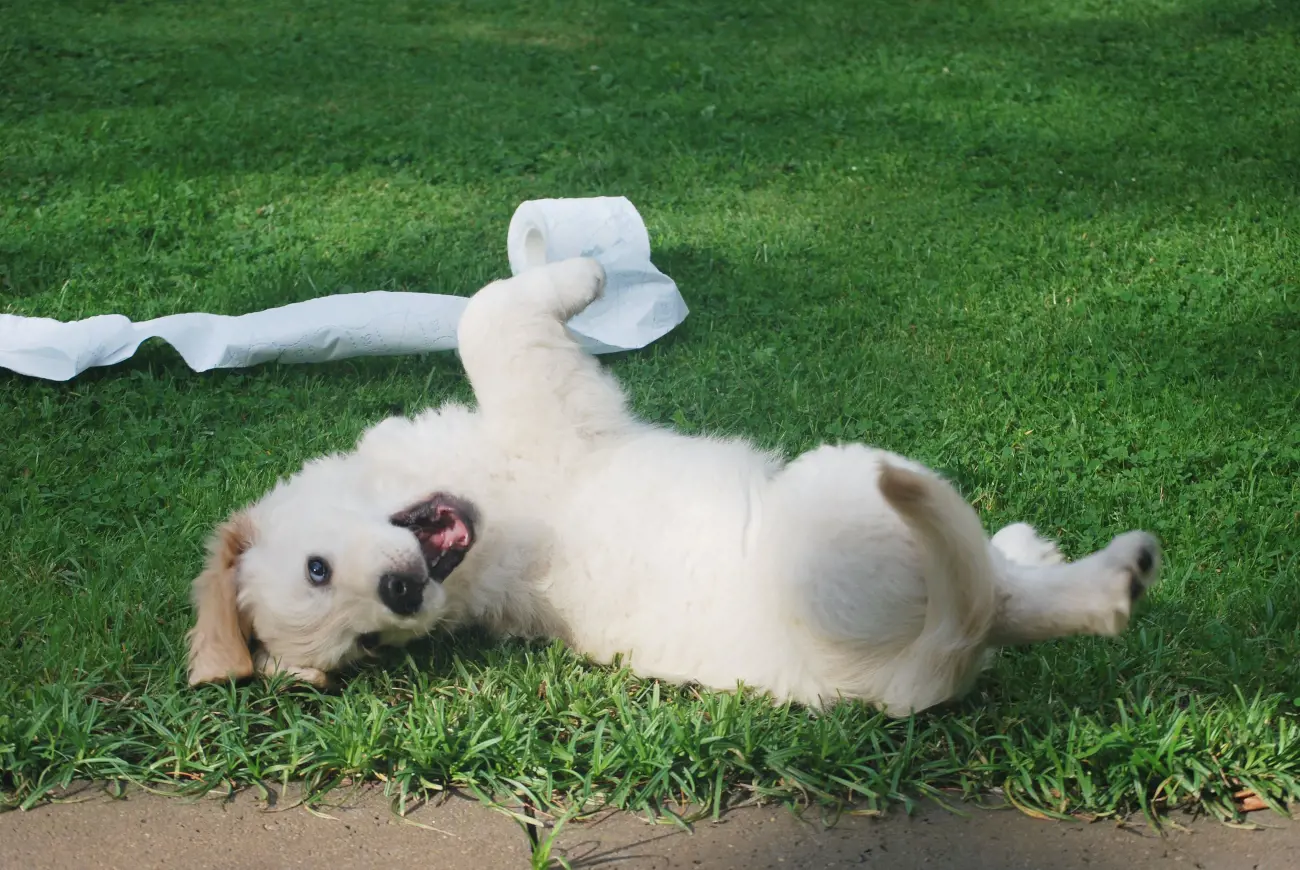A-Z of dog health problems - part 2
29th November, 2021

There are more dog ailments than you can shake a stick at – which is why our A-Z of dog health problems justifies being a two-parter (read part one here).
Having covered A-M in the alphabet, we now move on to N-Z, in which we touch on everything from nasal mites to zoonotic viruses.
Every canine will suffer from ill health from time to time, but with specialist pet insurance in place, you don’t have to delay getting them the treatment they need.
Purely Pets offers Defaqto 5* rated insurance products so you can protect your loyal friend throughout the course of their life.
So let’s take a look at some of the health issues that your pup could encounter along the way.

N is for Nasal mites
The idea of mites living in the nasal passages and sinuses of your dog does not bear thinking about. However, it’s been reported in dogs of all breeds, ages and sexes – with dogs older than three years of age and large breeds said to be more susceptible than others to nasal mites.
Although the organism presents no threat to humans, dogs can easily transmit between them with both direct and indirect contact with other infected dogs.
Clinical signs of nasal mites include nose bleeds, sneezing, ‘reverse sneezing’ (in which they take air into the nose), facial itching, nasal discharge, noisy breathing and impaired ability to pick up on scents. In more serious cases, a dog can even collapse from nasal mites.
Most of the time, thankfully, there’s not a great deal to worry about, but a trip to the vets will certainly be required. Once diagnosed with an endoscope and some nasal flushing, a treatment will be advised (usually some form of antiparasitic medication).
O is for Obesity
Just as with humans, obesity in dogs can lead to all kinds of serious health issues, while making any existing problems worse. Dr Dan O’Neill, Senior Lecturer, Companion Animal Epidemiology at the Royal Veterinary College says “obesity is the enemy of the health of our dogs”.
He’s not wrong. According to one report by Burgess Pet Care, more than half of the dogs in the UK are now categorised as obese.
If you’re concerned about how much weight your dog is carrying, the first thing you should do is carry out some at-home checks – such as feeling for the outline of their ribs – to see if you can see the signs of obesity. If you’re a little unsure, you can rely on your vet to provide some much-needed honesty!
Whether or not your dog is deemed clinically obese or not, check out our guide to healthy treats for dogs.
P is for Pancreatitis
Obesity can lead to pancreatitis, which is a potentially life-threatening illness for dogs if it isn’t treated adequately enough, early enough. For that reason, it’s important to be informed about the clinical signs of pancreatitis, even if your pup never develops the condition.
The pancreas’ job is to release enzymes that aid in digestion. In normal circumstances, the enzymes reach the small intensive before they activate. But in a dog with pancreatitis, the enzymes activate as soon as they are released, causing inflammation and damage to the pancreas, digesting the organ itself.
It’s as painful for your dog as you might imagine, and requires immediate treatment. The clinical signs to look out for include repeated vomiting, diarrhoea, loss of appetite, dehydration, fever and your dog displaying a hunched-back position.
The best way to avoid your pup picking up pancreatitis is to ensure they maintain a healthy diet and avoid high-fat foods – but some breeds are genetically predisposed to the condition.
Q is for Quivering jaw
A quivering jaw isn’t always a cause for concern – they might just be excited to see you or trying to tune into their senses. However, it can also be a sign that they’re struggling with anxiety or oral pain.
Ultimately, you know your dog best – if you’ve never noticed them chattering their jaw before, it might be worth taking them to the vet to see if they think anything is up.
R is for Ringworm
In many ways, ringworm is something of a misnomer – it’s not actually a worm and often isn’t even ring-shaped! Instead, you need to be on the lookout for patches of raised, red, crusty skin – often the fur around the infection site will fall out and will cause your dog to itch.
Ringworm is a fungal skin infection, which is very contagious and can easily spread to humans and other species. So, you need to be on the ball with treatment. Speak to your vet as soon as you suspect ringworm and, until they are seen, keep contact with your dog down to a minimum. If you have other pets in the house, keep your dog away from them as much as possible (we know this isn’t always easy).
Treatment for ringworm in dogs typically involves your pet having their coat clipped before a medicated shampoo and antifungal medication is applied. When providing treatment to your dog at home, make sure you wear gloves and use disinfectant in and around your home.
It usually takes a couple of weeks for treatment to take effect – the cost of which can quickly escalate, so make sure you have pet insurance in place to provide some cover.
S is for Skin cancer
Skin cancer in dogs is often brought on by exposure to the sun, but it’s not always as clear cut. Compulsive licking of certain areas of skin can also lead to cancer, while some breeds are genetically predisposed to contracting the disease. For example, dogs with light skin, a thin coat or a lack of fur are more prone to skin cancer (you could say this comes back to sun exposure again).
However, it remains the case that the sun is the biggest cause of skin cancer in dogs. You won’t always want to keep your pup indoors – but you might want to shelter them from the sun at times of peak UV intensity, usually between 10am and 3pm.
The application of a specially formulated canine sun cream can go some way to protecting your dog’s sensitive skin. But constant exposure to the sun, even with sunscreen, can cause skin cancer to develop over time.
Skin cancer may form in the shape of lesions, scabs, warty lumps and bumps on the skin. So, when giving your dog a bit of love, keep an eye out for any unusual lumps and bumps and book a visit to your vet should you have any reason for concern. You could even call the Purely Pets’ 24-Hour Vet Helpline for advice.
Find out more about different types of skin cancer in dogs now.

T is for Ticks
Ticks are small, spider-like parasites that suck the blood of other animals. Similar to spiders, they have eight legs, along with a body that gets larger and darker with more blood they suck.
Ticks carry diseases. So, in the event your beloved pet pooch was to fall ill because of a tick bite, having pet insurance in place may help to recuperate some of the costs associated with vet visits and treatment.
If you notice a tick on your hound, you need to remove it straight away – but you need to do it the right way. It’s important not to squeeze the body when removing the parasite, or leave the head in the skin. Squeezing the body means that blood could end up being squeezed back into your pet’s body, increasing the risk of them getting a disease.
Use a special tick removal tool to twist the critter out, and ensure the head isn’t left inside your pet to cause more damage. These tools are inexpensive and can be purchased from your vets, local pet shop or online.
There are many spot-on treatments that can be combined with your pet’s flea treatment to safeguard them against ticks. These work as they enter the animal’s circulatory system – when a flea or tick takes in their blood, it quickly kills them off.
U is for Urinary tract infection
Just as with humans, a UTI can make it unpleasant and uncomfortable for a dog to pass urine. Usually a UTI is caused by a bacterial infection. However, similar signs like passing urine more frequently than usual, blood in the pee and licking the area more than usual after urination may be seen with other conditions such as urinary stones and crystals, bladder inflammation and kidney disease.
Urinalysis, in which a urine sample is tested for acidity, blood, infection, sugar, concentration and crystals, will be the first thing that your vet will carry out should you suspect your dog has a UTI. Treatment options will depend on what the results show.
V is for Vomiting
As you will have picked up over the course of this A-Z guide, vomiting is a common symptom of many different conditions – some serious, some less so.
The general advice is that, if your dog’s vomiting is persistent (for more than a 24-hour period), you should start to take it a bit more seriously and speak to a vet.
Here at Purely Pets, as part of all of our pet insurance policies, we offer a 24-Hour Vet Helpline that you can call when your dog shows any signs of illness.

W is for Water safety
Most dogs can’t resist jumping into open water when they’re out on a walk. But you need to be mindful of where you let your pup paddle as they might pick up something pretty unsavoury if you’re not careful.
One of the biggest dangers posed by open water is that of blue green algae poisoning. More scientifically known as cyanobacteria, it’s a group of algae-like bacteria which contain harmful toxins that can prove fatal for a dog.
It all depends on the size of your dog and the quantity of toxins consumed – but there’s often no way of telling the latter. Treatment for blue green algae poisoning is complicated. Unfortunately, there’s no antidote, so vets have to resort to trying to rid a dog’s body of the toxins through vomiting and stomach pumping.
It’s about as unpleasant as it can get for a dog – read more about blue green algae poisoning here.
X is for Xylitol poisoning
Xylitol is a common sugar substitute that makes our food and drink taste a little bit sweeter – but it can be toxic to dogs.
Blue Cross reports that there are hundreds of cases of xylitol poisoning in dogs reported in the UK each year, with chewing gum being the biggest culprit. Clearly, prevention is key – keep all human food out of reach of dogs so that their innate curiosity doesn’t get the better of them.
Y is for Yeast infection
Yeast infections are a common problem for dogs, flaring up in and on several parts of the body. Yeast can grow anywhere on the skin, but the most commonly affected are the ears, paws and skin folds.
A dog with a yeast infection will itch the affected area which will be red and smell off. If a yeast infection is left untreated, it can cause the skin to thicken and turn rough and black.
Treatment for yeast infections typically involves the prescription of an oral anti-yeast medicine, lotion, and specially formulated shampoo.
Z is for Zoonotic viruses
For many people, the term ‘zoonotic disease’ might have first appeared on their radar during the COVID-19 pandemic. Coronavirus is a zoonotic disease believed to have jumped from an animal to humans.
Examples of the most common zoonotic diseases in dogs include ringworm, Lyme disease and rabies, all of which can be passed to their unsuspecting owners if you’re not careful.
Pet insurance from the specialists
Here at Purely Pets, our pet insurance policies are designed to provide cover for a dog’s entire life.
Helpful Pages
Recent Posts
Pet Insurance Quote
- 98% claims paid *
- Claims paid directly to vets
- 24/7 vet video consultations
- Interest free monthly payments




